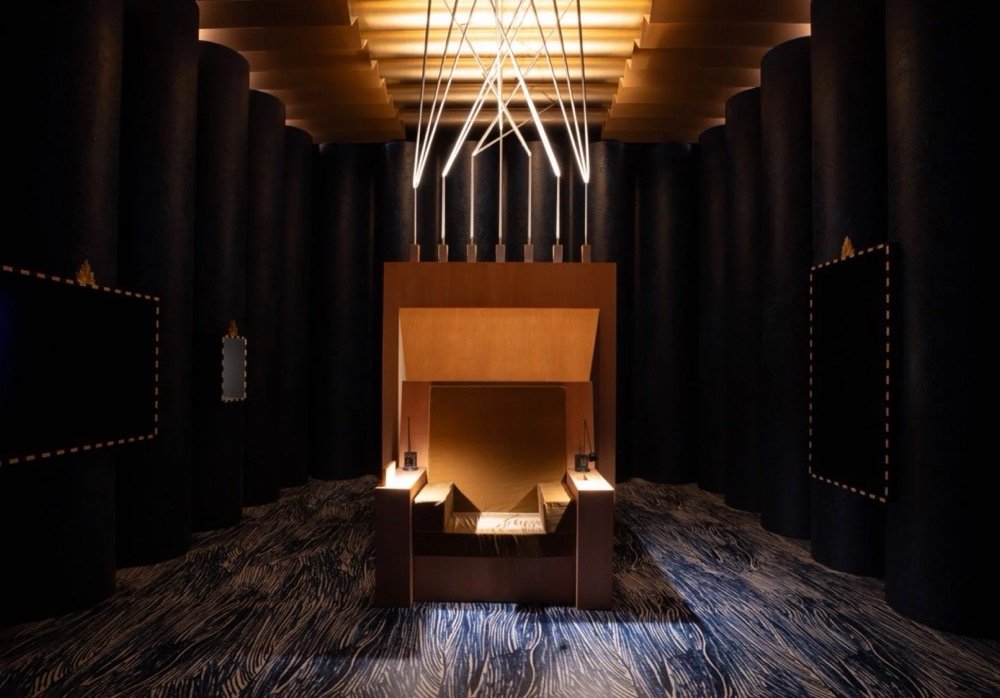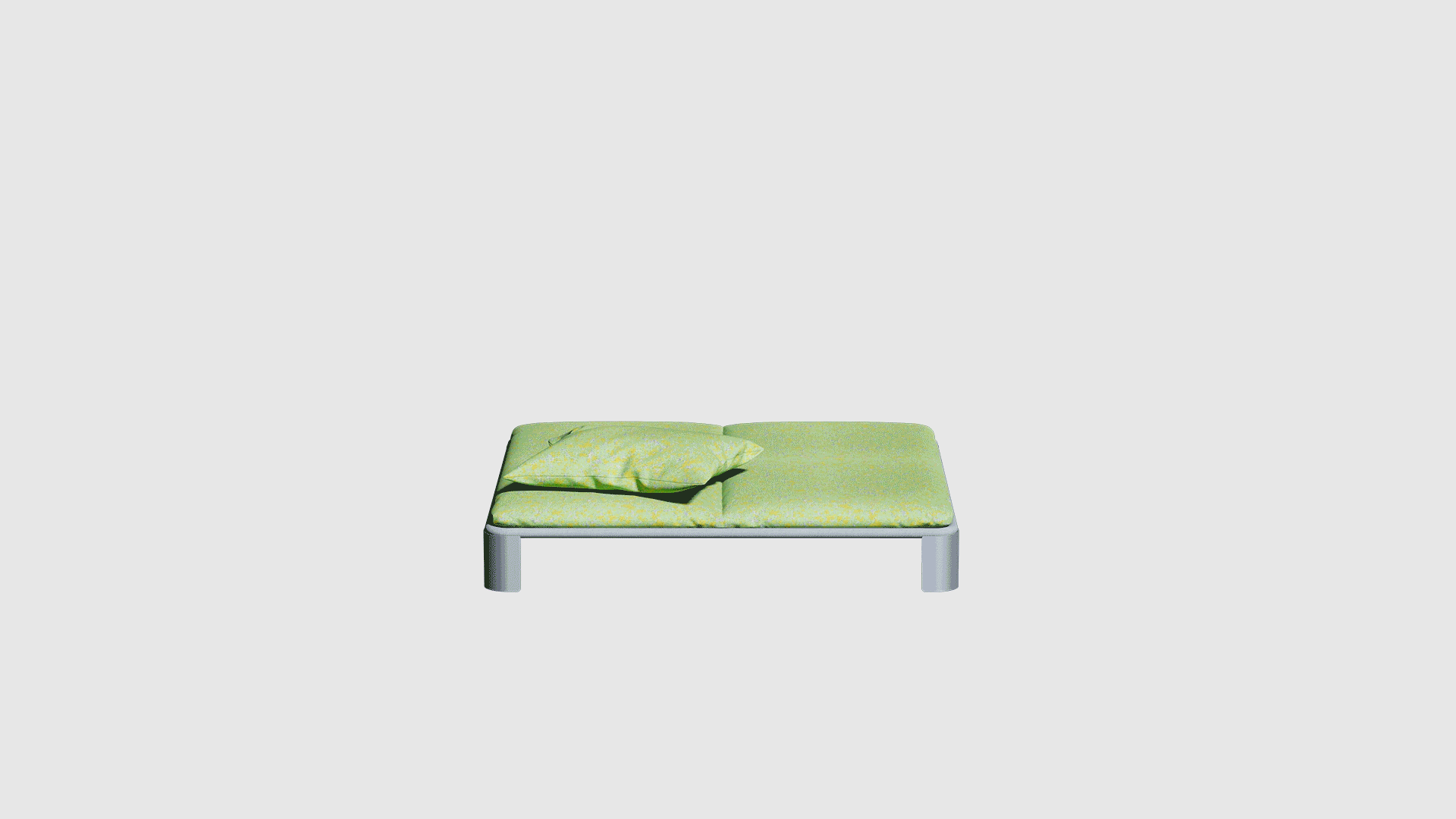David Lynch's "A THINKING ROOM" installation
via Dezeen ::
via Dezeen ::

Lynch had a clear vision for the space from the beginning, taking an interest in the materials and colours used and even creating a small decorative sculpture that sits at the top of the picture frames that hang on its walls.
"We sent him twelve samples for the walls, with more texture and less texture and many different blue shades," di Benedetto said. "He was happy like a child when he received all of the samples in LA."
On top of the large chair, seven metal rods connect it to the ceiling, where they branch out. Like the often ambiguous images in his films, the design was left unexplained by Lynch.
"The only thing that we know is that these are the connections between something like the soul and the absolute; a flow of energy from your soul," Monda said.
Common mistake. :: Dog DNA Company Insists Human DNA Is Actually Alaskan Malamute | Futurism
Loved BAD LIEUTENANT: PORT OF CALL NEW ORLEANS and I am well and truly stoked for their reunion :: Nicolas Cage to Star in Werner Herzog's ‘Dead Man's Wire' | World of Reel
Did they finally get it right? ::
AI-powered calculator concept can solve even handwritten math problems | Yanko Design
YES :: ‘Peaky Blinders’ Movie Set to Shoot in September, Cillian Murphy to Star | World of Reel
Very excited for this: Farrell owns the role ::
Around The World in 1896: See Colorized & Upscaled Footage of Egypt, Venice, Istanbul, New York City, London & More | Open Culture
Kinda love the watchband :: Industrial Product Design Trends For 2024 | Yanko Design
Prehistoric creature named after Kermit the Frog offers clues on amphibian evolution, scientists say | ABC News
And we're back to the weekly list: Squarespace changed up their iPad editor and made it impossible to add links, so it's simpler to do it this way and put it together once a week on the Mac.
As if the beauty of her work as a whole wasn’t amazing enough, her attention to the smallest detail never ceases to amaze :: Star Costume Designer Ruth E. Carter on Fashioning Afrofuturism | artnet
The black and white photos of Macdonald's work are incredible; like PDR, I can only imagine how amazing the color was in reality :: The Art of Sutherland Macdonald, Victorian England’s “Michelangelo of Tattooing” (ca. 1905) | The Public Domain Review
🤯🤯 :: Immersive Bamboo Installations by Asim Waqif Whirl and Heave in Monumental Motion | Colossal
The Armored-Knight "Robot" Designed by Leonardo da Vinci (circa 1495) | Open Culture
Better late than never, I suppose :: Keurig Just Killed The Coffee-Pod With Their New Biodegradable Compressed Coffee Pucks | Yanko Design
At last, an AI with impeccable gaming taste :: Google DeepMind’s Latest AI Agent Learned to Play 'Goat Simulator 3' | WIRED
Someone has to have the adaptation option on this story, right? :: The Ghost-Busting 'Girl Detective' Who Awed Houdini | Atlas Obscura
Very cool :: Teen Titans Live-Action Movie in the Works at DC Studios | The Hollywood Reporter
And, finally, re-linking / linking within to the teaser for MOUSE, an upcoming game from Fumi Games that takes the CUPHEAD / Tex Avery aesthetic and turns it into an FPS.
I've been familiar with Vidocq's wild story for awhile, but this excellent longread is a perfect summation: Eugène-François Vidocq and the Birth of the Detective | The Public Domain Review
Artist Pandora Graessl’s Transportive “Amor Fati: When the Fire Bit Me” Exhibition | Cool Hunting
The five finished minutes included in this piece are incredible: The Russian Animators Who Have Spent 40 Years Animating Gogol's "The Overcoat" | Open Culture
Yours for $25k: Brian Eno's light-up turntable changes colour in "complex and unpredictable" patterns | Dezeen
Art Bites: Surrealist Painter René Magritte Was a Master Forger, Too | artnet
Autodidacts FTW: Noriko Sugiyama Transforms Old Kimono Into Luxurious Landscapes | Spoon & Tamago:

At around age 60, with her 3 children all grown up and out of her hands, Sugiyama decided to relocate from Saitama up north to Iwate prefecture where she had relatives, and was closer to her birthplace of Aomori. She obtained her chiropractors license and opened a small practice where she served the local community for over 10 years.
One day, Sugiyama found a pack of discarded colored markers near a dumpster. Noticing that they were still in good shape, she decided to take them home and begin doodling. Soon, images of trees and rivers all inspired by the nature of Aomori began pouring out of her and onto the pages of a sketchbook. After a year or so of sketching with the markers, Sugiyama remembered her mother’s colorful kimonos that had been stored away. There was no use for them in storage so the artist, whose creative juices were now flowing, decided to begin incorporating them into her work, which eventually led to a style she has coined as “Kimono Reborn Art.”
Excited for this one: Wagner + Jones + Dracula = instant sale: Dark Horse to bring DRACULA BOOK 1: THE IMPALER to eager blood fiends this October | ComicsBeat
Fourteen views of Himeji Castle | {feuilleton}
Favorite headline of the week: Yakuza member selling soda arrested for extorting money from ninja spreading flyers in Asakusa | SoraNews24
Seatbelts inform Steady walking aid for elderly dogs | Dezeen
‘Black Panther’ Costume Designer Launches Otherworldly 3D-Printed Handbags | Yanko Design
Dream home = found: A Pair of Backyard Cabins Are Worlds Removed From Their Main Residence—But Only Steps Away | Dwell
And finally, a wonderful look inside OSU's Billy Ireland Cartoon Library and Museum. Need to make a return trip sooner rather than later… Inside the World’s Largest Comics and Cartoons Collection | Hyperallergic
Beautiful and intriguing design principles here (via Print Mag):

Looking at an Unbound Edition Press book, all I see are possibilities. Because the covers are about color, you absorb the mood and tone that sparks your imagination without, for example, an image of a screaming eagle hitting you over the head. That doesn’t mean the team at Unbound Edition Press doesn’t respect the work of book designers. “There are brilliant book covers designed by talented designers. But I don’t subscribe to the idea that the cover should illustrate the book,” Davis says. “We prefer a simple approach that conveys the book’s tonality, mood, and spirit through text and color.”
These are absolutely stunning. Full series of photos at Spoon and Tamago:

After 8 minutes of ethereal and lightweight fabrics breezing through the walkway, the lights dimmed on Takahashi’s show and glowing dresses began to slowly float down the runway like deep-sea jellyfish.
Filled with roses and butterflies, the terrarium dresses illuminated the concrete catwalk, presenting a breathtaking mix of precarious instability and chaos. Once again, Takahashi lived up to he reputation for one of the most darkly enchanting, rebellious, and often bizarre imaginations in today’s world of fashion.
via The Awesomer:
Creator Elias Jarzombek on this amazing thing:
Abacuysnth is a synthesizer inspired by an abacus, the ancient counting tool used all around the world. Just like an abacus is used to learn the fundamentals of math, the Abacusynth can be used to explore the building blocks of audio synthesis.
It exists in two forms, one digital and one physical, that are both based on the same primary interaction: placing and manipulating shapes on rods. The visual and tactile control makes it easy and fun to create rich timbres sounds without having to fiddle with lots of knobs and sliders.
From Space 10, a reimagining of the couch via AI:
The couch is synonymous with comfort. The centre of our living rooms, it is where we unwind, chat with friends, read, nap, and relax. Yet, the established design archetype of the couch — heavy, bulky, difficult to transport — feels increasingly outdated in an age of flexible living and ever-changing lifestyles.
We collaborated with Panter&Tourronto reimagine the couch as something that is light, adaptable, and comfortable — challenging generative AI to liberate the couch from its historical form.
The result is Couch in an Envelope, an AI-assisted exploration rethinking the design of the couch. A speculative concept that is flat-packed, modular, and would only weigh 10 kilograms.

Truly cool and nifty and fascinating – but can it withstand dogchildren?
Designed by the folks at Augmental (a spin-off of the MIT Media Lab), the MouthPad is a Bluetooth-powered mouthpiece that lets anyone control electronic appliances with their tongue. A touch-sensitive panel sits against the roof of your mouth, allowing you to use your tongue as a finger of sorts to navigate interfaces. Tongue taps are registered as left clicks, while mouth gestures like pursing your lips (pouting duckface, for the Millennial and Gen Z readers) registers a right click. Through the MouthPad, individuals can now perform a variety of tasks with just their tongues. These tasks include sending emails, illuminating a room, enhancing photographs, and even engaging in video games. Additionally, Augmental guarantees that the mouthpiece’s sleek design will not impede speech, allowing users to communicate verbally with ease while wearing the device.
Davidson Prize longlist features 16 designs to mitigate homelessness | Dezeen
Stunning: Ai Weiwei Unveils Recreation of Monet's 'Water Lilies' Made Entirely of Legos | Smithsonian Magazine
jesusfuckingchrist: The Mass Shooting Database | Maps Mania
If it doesn’t contain a cheeky double entendre about King Charles’s leaky pen or use it as a weapon, it’s a missed opportunity: James Bond Story Commissioned to Celebrate King Charles' Coronation | Variety
When the Shadow Detonated an Atom Bomb in Brazil in 1947, at Auction | Bleeding Cool
Korean publisher investigated following suicide of Black Rubber Shoes creator | The Beat
Mathematicians Have Found a Shape With a Pattern That Never Repeats | Smithsonian Magazine
"Our basic premise is that Impressionism… contains elements of polluted realism...": Did Monet Owe His Hazy, Impressionistic Style to the Early Effects of Climate Change? A New Scientific Study Suggests So | Artnet News